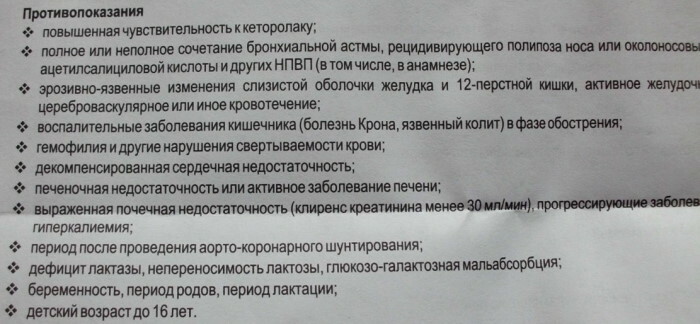Content
- When is ankle orthosis indicated?
- Contraindications
- Types of orthoses
- Soft, light to medium hold
- Semi-rigid, strong hold
- Tough, strong hold
- Additional elements
- Children's orthoses
- Selection recommendations
- The size
- Model
- Rules of operation, care of the product
- How long should you wear?
- Top brands of orthoses
- Where to buy, prices
- Video about orthoses
Ankle brace is external device for supporting and restoring the function of the musculoskeletal system. With the help of rigid and strong fixation of the joints, it is possible to change the structural and functional characteristics of the skeletal and neuromuscular systems.
When is ankle orthosis indicated?
The ankle joint is one of the largest; when walking, the greatest load is exerted on it. Any injury in this area will restrict the person's movement. Orthoses help to cope with pain, restore joint mobility. Protective devices are much more effective than elastic bandages, plaster pads.
Orthopedic products are part of the treatment regimen for many foot and ankle problems.
Indications:
- To correct flat feet, doctors recommend wearing orthoses.
- To guarantee additional support, cushioning in the area of the ball of the foot, heel.
- Orthopedic devices can sometimes help avoid invasive treatments such as surgery.
Orthopedic products are indicated for the treatment of diseases:
- Arthritis. Rheumatoid forms of arthritis and osteoarthritis cause pain and discomfort in the joints, and orthoses help damaged joints stay calm during inflammation.
- Back pain. Often, misaligned feet, such as curled feet or lack of shock absorption, cause pain that can be relieved with orthopedic products.
- Achilles tendon bursitis. Inflammation of the fluid-filled bursa located on the posterior calcaneal surface. Heel supports and arches reduce the discomfort caused by inflamed bursae around the joints.
- Diabetes. In diabetic neuropathy, orthoses relieve excess stress and pressure on the foot that leads to ulceration.
-
Flat feet. The disease causes pain in the ankle, radiates to the back. Supportive orthopedic products help to train the musculo-ligamentous apparatus of the ankle.
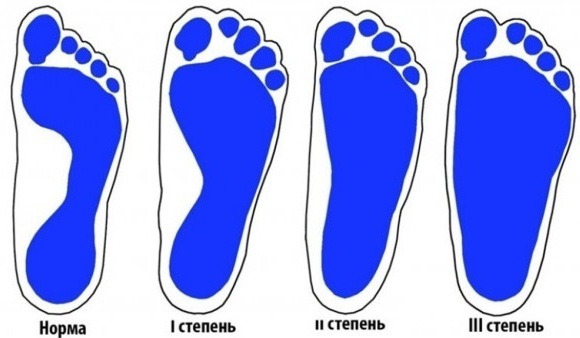
- Curvature of the thumb. The disease develops as a side effect of thorns on the big toe, which cause deformity in the ball of the foot and pain. In this case, orthopedics performs the function of supporting the feet, reducing the risk of worsening the situation.
- Heel spurs. Fasciitis is a condition in which extra bone grows on the back or bottom of the heel. Orthopedic support in this case is necessary to reduce the inflammatory process.
- High arch of the foot. Incorrect anatomy of the longitudinal and transverse arches, high arcs strain the muscles of the legs and lead to discomfort, pain in the knee, lower leg, and the development of plantar fasciosis.
- Wounds. People who have suffered a leg or ankle injury may need additional support with orthopedic medications during the healing phase.
- Hanging foot. A neurological disorder in which the toes rub against the floor when walking.
- Stroke, spinal cord injury. People who have had these diseases have impaired walking function. In some cases, orthoses help restore motor function.
- Cerebral palsy. Orthotics for children diagnosed with pediatric CP is an effective method of preventing the development of pathologies of the musculoskeletal system.
- Polio. After the acute phase of the disease, the use of the orthosis can increase the mobility of the ankle.
- Multiple sclerosis. A disease that affects the walking of people. Mobile ankle braces help repair weakened dorsiflexion muscles.
And also for people with weak muscles of the legs and feet, doctors prescribe individual orthopedic preparations. Ankle orthosis (rigid) with strong fixation is an effective device for unloading and stabilizing the anatomical articular parts of the leg.
Contraindications
There are a number of restrictions for wearing orthoses:
- skin diseases;
- open wounds at the points of contact of the orthopedic device;
- diabetic neuropathy with ulceration;
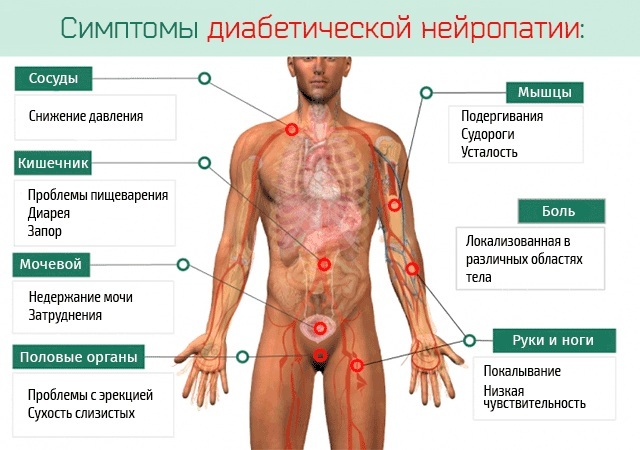
- open fractures;
- high swelling of the ankles;
- trophic ulcers;
- allergy to the material from which the orthosis is made.
Types of orthoses
Orthopedic devices are sold in specialized stores, pharmacy departments, or made to order according to special parameters.
Orthopedic products are produced in several ways:
- Serial. They are made according to the same sample and are suitable for many patients.
- Prefabricated modular. They have a sophisticated design and are designed to be individually worn.
- Non-standard. They are made by hand at the request of the patient and taking into account his clinical and anatomical characteristics.
Various materials are used in the manufacture of products: synthetics, fabric, plastic, metal.
Soft, light to medium hold
Elastic bandages have medium or light fixation. These devices are designed to be worn as a preventive measure against injury. They are made of breathable materials and have additional properties: massage, compression, warming. The products are easy to wash, hardly noticeable under clothes, and are comfortable to wear.
Semi-rigid, strong hold
Semi-rigid orthoses have stiffening ribs, with the help of which the joint is fixed in the correct direction. Outwardly, they look like boots with adjustable fasteners: straps, Velcro or wide ribbons. 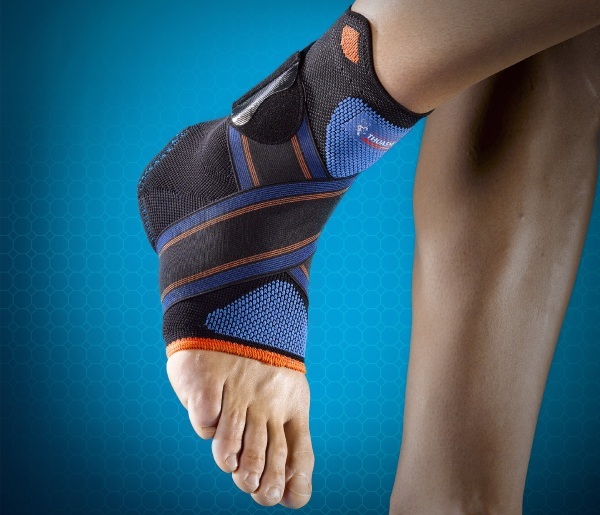 Silicone pads are inserted inside the products, plastic or metal knitting needles are laid on the sides for rigidity. Designed to relieve the joint when walking, to protect the ligaments.
Silicone pads are inserted inside the products, plastic or metal knitting needles are laid on the sides for rigidity. Designed to relieve the joint when walking, to protect the ligaments.
Tough, strong hold
The ankle brace is rigid, strong fixation, designed to fully stabilize the joints. Structurally, this device is very durable. Immobilization is carried out using special tires, spokes, metal plates. The inner lining is made of soft materials, the whole structure is secured to the leg with straps, lacing or fasteners with adhesive tape.
Additional elements
Rigid orthoses can have accessories that complement the basic functional properties:
- Silicone or gel inserts to reduce shock absorption when walking.
- Air-filled pneumatic chambers. The amount of air pumped in affects the internal volume of the orthosis and the compression force on the ankle.
- Special metal plates that hold the joint in the desired position.
- Hinges. With their help, the size and mobility of rigid orthoses are regulated.
- Buckles in the form of a belt, lacing or special sticky devices.
Children's orthoses
First of all, children's bones are significantly different from adults. Their bones are softer than those of adults. But as children grow and develop, the bone framework is strengthened along with them.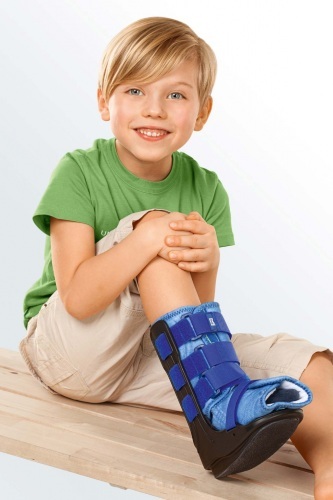
The biggest difference in the structure of children's and adult bones is the presence of growth plates in children's bones. This significantly changes the methods of treatment and rehabilitation after injuries and is taken into account in the manufacture of orthoses.
Children need rigid fixation of the ankle joint for fractures of the bones of the foot, rupture of ligaments, after operations, in the case of cerebral palsy.
Children are offered devices with adjusting joints, dynamic orthoses.
For the children's ankle joint, special splints have been developed, designed to fix the lower limb.
They are used for paralysis of the muscles of the lower leg, foot, traumatic injuries of soft tissue, bones. It is used for congenital defects of the lower extremities, acquired clubfoot.
When buying, children's products are determined by the size of the shoe, the volume of the lower leg does not matter.
Selection recommendations
Ankle brace is selected depending on the nature of the joint lesion. Rigid, strong fixation of the structure is shown for maximum unloading of the lower limb. For a brace to be useful, it should be selected under the guidance of a specialist. The orthopedic surgeon determines the degree of the lesion, selects the size, model, talks about the procedure for care and operation.
The size
A well-chosen product helps to accelerate the healing of injuries, provides the necessary level of support for the ankle joint.
To determine the correct size, you should measure the length of the foot, the circumference of the lower leg, the circumference of the ankle. The ankle is measured below the bone through the heel. All data must be compared with the numbers indicated in the instructions. Each company that produces orthoses has its own grid.
Most manufacturers adhere to the following dimensional grid:
| European size | Ankle circumference, cm |
| S | 16–20 |
| M | 21–24 |
| L | 25–31 |
| XL | 32–36 |
| XXl | Over 36 |
If the patient's leg size is between two digits, then the size range should be chosen downward. Since the orthosis chosen for the size will not be able to rigidly fix the joint anymore and there will be little benefit from it.
Model
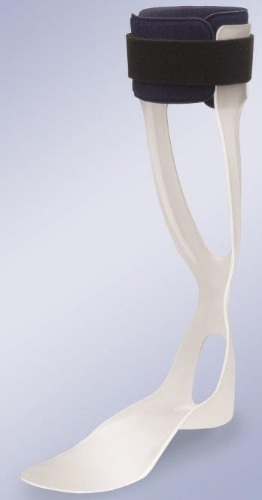
Rigid devices are of 3 types:
- Traumatic. They help with joint recovery after fractures and surgeries. Bones are rigidly fixed, allow the joint to be completely immobilized, and are often equipped with a pneumatic chamber.
- Orthoses for sagging feet. Recommended for inadequate flexion of the dorsum of the foot, paralysis of the anterior leg muscles. They are made of thermoformed thin plastic, lightweight.
- Derotation (non-rotating) boot. A rigid brace is similar in shape to a boot. There is a crossbar on the outside of the heel. It is necessary so that the leg and foot are fixed at a right angle and cannot move to the side.
Rules of operation, care of the product
Ankle brace is rigid, strong fixation should not be washed with water. During wearing, you should monitor the hygiene of the feet, avoid rubbing. Cotton socks should be worn on your feet, which should be 4–5 cm higher than the orthosis. The device is attached to the leg while sitting. Several times a day, the product should be removed and the inner surface should be treated with an antiseptic.
As the joint recovers, the straps and buckles should gradually loosen. This is necessary for better blood circulation, strengthening muscles, increasing the range of motion of the joint.
How long should you wear?
The duration of use depends on the nature and degree of joint damage. The time of wearing hard-fixing products is from several weeks to several months.
The daily wear time is also determined by the doctor. It can range from up to 8 hours a day.
In the first days, the orthosis should be worn for no more than 30 minutes, and then every day the time increases to the desired indicator, which is prescribed by the doctor.
The ankle support is rigid, strong fixation should be removed at night and during daytime sleep. For some types of diseases, it is not provided for the removal of the orthosis at night. In this case, it is necessary to loosen the straps to reduce the risk of excessive compression of the blood vessels.
Top brands of orthoses
High-end orthopedic products combine the knowledge of anatomy, biomechanics and engineering. A well-chosen device should bring relief to a person after operations, injuries and illnesses.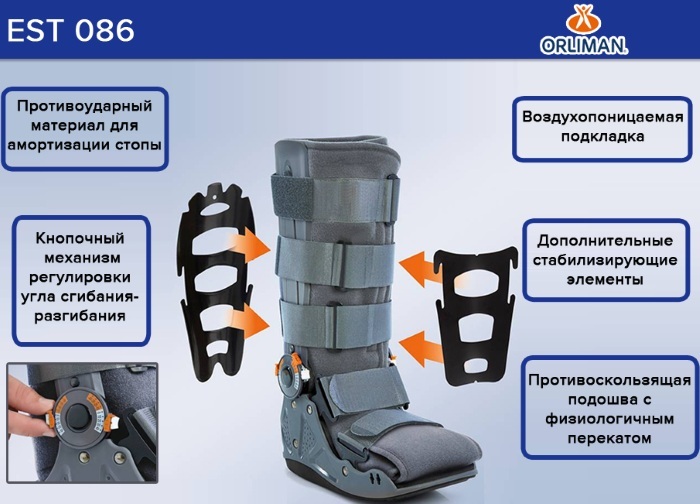
The most popular firms producing rigid orthoses:
| Company name | Fixation degree | Indications for use |
| Orliman | Immobilizing device | Rehabilitation after surgery, trauma, acute plantar fasciitis. |
| Orliman EST-086 | Immobilizing hinge device | Ankle ligament paresis, foot ulcers |
| Orlett | High orthosis, with metal splints that create stiffening ribs | Injuries to the ankle ligaments, Achilles tendon, postoperative rehabilitation, flaccid paralysis of the foot. |
| ROM Walker | Easy-to-adjust hinges, Velcro fasteners, plastic pads | Postoperative rehabilitation, treatment of forefoot fractures, ruptures of the Achilles tendon. |
| TNO-23 | Derotation boot | Wearing with cerebral palsy, in case of spinal cord injury, a threatening condition of hallux valgus. |
| Orliman TP-2100 | A derotation orthosis with Velcro fasteners, the model is adjusted to the individual characteristics of the patient. | Drop foot syndrome, unilateral paralysis, plantar fasciitis. |
| Orliman EST-085 | Orthosis with foam-gel pads that take the anatomical shape of the leg. It is made of thermoplastic with Velcro fasteners. | Tendinitis, sprain, rehabilitation period after surgery, ligament rupture. |
| Orlett HAS-337 | The orthosis with a pneumatic chamber provides full fixation of the foot, has a soft insole that prevents a shock wave, and can be worn over surgical dressings. | Tendon-ligamentous apparatus injuries, uninfected forefoot wound, possibly worn by patients with diabetic foot. |
| WALKER Boot | Stiff fit, one size fits all kids | Postoperative rehabilitation, rupture of ligaments, fractures of the ankles without comparing the fragments. |
| Fosta FK 2822. child |
The orthosis is rigid, fixes the lower leg in the frontal plane | Fractures of the Achilles tendon, ankles, ankle instability, foot sagging, Achilles bursitis. |
| Fosta FS 2950 child |
Supportive support of the foot, made of plastic, provides support for the ankle and the lower third of the lower leg in the frontal plane. | Used for sagging feet |
| Ekoten | Ankle bandage with lacing, with metal stiffening ribs, joint fixators. | Sprains, ankle injury, sagging foot, rehabilitation after ankle surgery. |
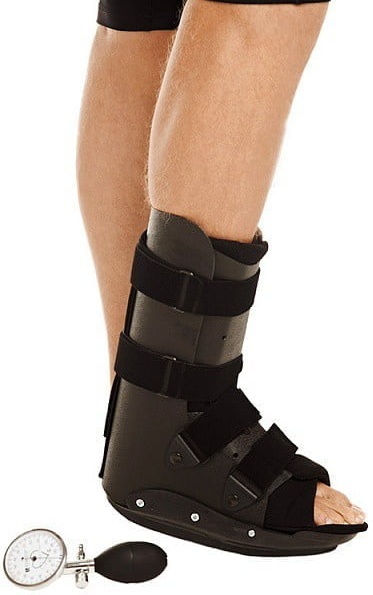
When choosing an orthosis, you should pay attention to the company, the price of the product. In the process of restoring motor function, cheap adaptation does not mean better.
When choosing a product, you should pay attention to the following points:
- ease of dressing;
- wearing comfort;
- ease of care of the product.
Where to buy, prices
Ankle brace should be purchased in specialized salons or pharmacy departments. The device should always be tried on before buying, check for a certificate. The cost of ankle orthoses starts at $ 2,000. RUB 500 Complex structures can cost from $ 6 to $ 20 thousand. rub.
The effect of the therapeutic effect depends on how correctly the orthosis for the ankle joint is selected. Treatment of pathologies of the joint capsule often depends on the degree of rigidity and strength of fixation of the device. The main thing is a timely appeal to a specialist, and then joint work to restore motor function.
Author: Belyaeva Anna
Video about orthoses
Bandage, orthosis, ankle splint:

